Operations Process Resources - Plan
-
23-07: Military Decision Making Process (MDMP) - This handbook supports effective planning using the MDMP and references doctrine and CALL products. Its readers should be proficient and familiar with doctrinal and CALL references that provide, in greater detail, the foundation and lessons/best practices for planning processes. Note: Army Techniques Publication (ATP) 5-0.2-1, Staff Reference Guide, Volume I, Unclassified Resources, 7 December 2020, and Field Manual (FM) 5-0, Planning and Orders Production, 4 November 2022, are doctrinal references that provide common responsibilities for operation order and annex production. Note: Access requires CAC credentials.
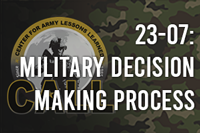 For more lessons learned and up-to-date content, visit the restricted CALL SharePoint site. Note: Access requires CAC credentials and site registration by CALL team.
For more lessons learned and up-to-date content, visit the restricted CALL SharePoint site. Note: Access requires CAC credentials and site registration by CALL team. -
Sustainment Preparation of the Operating Environment Process - Sustainment preparation of the OE is executed by sustainment planners and staffs to provide a basis for developing sound sustainable plans. This analysis allows the commander and staff to better visualize the OE and see how conducive the OE is to sustaining military operations (ATP 4-92 or ATP 4-93).
Click the Following Training & Evaluation Outlines (T&EO):
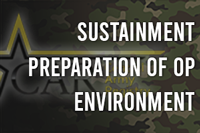
-
Tactical Sustainment Steps & Procedures During MDMP (TS2P-MDMP) - Tactical sustainment steps and procedures during MDMP provide a tailored approach to iterative MDMP planning methodology for sustainers to understand the situation and mission, develop a concept of support (course of action), and produce or assist in producing an operation plan or order. Tactical sustainment steps and procedures during MDMP were developed for sustainment planners to rapidly identify sustainment constraints or factors during mission analysis that inform course of action development to ensure feasibility. Rapid and early identification of sustainment constraints or factors enables early resource coordination with higher sustainment echelons, which reduces sustainment planning timelines (ATP 4-91).
Click the following Training & Evaluation Outline (T&EO):
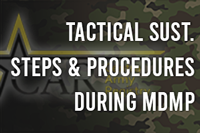
-
150-C2-5144: Develop a Running Estimate - The staff officer develops a running estimate that provides the commander and staff with a continuous assessment of the current situation within their functional area to determine if the current operation is proceeding according to the commander's intent, progressing toward achieving the desired end state, achieving mission objectives, and if planned future operations are supportable. Note: Access requires CAC credentials.
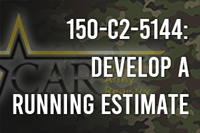
-
FM 5-0 - Appendix, Command & Support Relationships - This appendix defines and describes joint command relationships and other authorities, followed by a discussion of Army command and support relationships. It concludes with a discussion of command and control considerations for multinational operations.
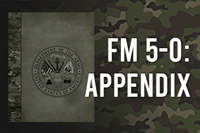
-
Wargaming Guide - Offers Planning, Wargaming, as well as Risk Assessment Tips and Techniques for any staff, battalion echelon or above. Note: Access requires CAC credentials.
 For more lessons learned and up-to-date content, visit the restricted CALL SharePoint site. Note: Access requires CAC credentials and site registration by CALL team.
For more lessons learned and up-to-date content, visit the restricted CALL SharePoint site. Note: Access requires CAC credentials and site registration by CALL team. -
Developing & Maintaining Running Estimates - Commanders use running estimates to drive both the decision making process, as well as a viable means of developing course of actions (COA) based on mission requirements. The groundwork of developing running estimates is rooted in identifying mission requirements, and variables affecting the Army's military decision making process (MDMP). Note: Access requires CAC credentials.
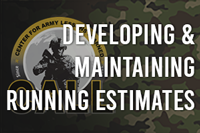 For more lessons learned and up-to-date content, visit the restricted CALL SharePoint site. Note: Access requires CAC credentials and site registration by CALL team.
For more lessons learned and up-to-date content, visit the restricted CALL SharePoint site. Note: Access requires CAC credentials and site registration by CALL team. -
Sustainment Force Structure Book - The Sustainment Force Structure Book is a data reference and resource that provides a snapshot of sustainment organizations by Standard Requirements Code (SRC). This snapshot includes a brief statement of the organization's mission and functions, capabilities, employment, basis of allocation, doctrinal mobility and dependencies derived from its base Table of Organization and Equipment (TOE). The information provided on sustainment organizations reflects a fully modernized and approved organizational structure for personnel and equipment. Modification Table of Organization and Equipment (MTOEs) for each organization will vary based on force management guidance and priorities. Note: Access requires CAC credentials.
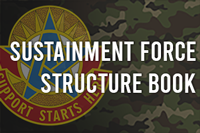
24-894: Staff Processes in LSCO - Running Estimates
- Staffs often present raw, unrefined data without analysis and are unable to provide the
knowledge commanders need to make decisions. Staffs across the Army need to better
facilitate commanders' decision-making during large-scale combat operations by focusing
running estimates on assessments, conclusions, and recommendations along with associated
risk and opportunities. Note:
Access requires CAC credentials.
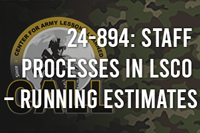
For more lessons learned and
up-to-date
content, visit the restricted CALL SharePoint site. Note: Access requires CAC credentials
and site registration by CALL team.

